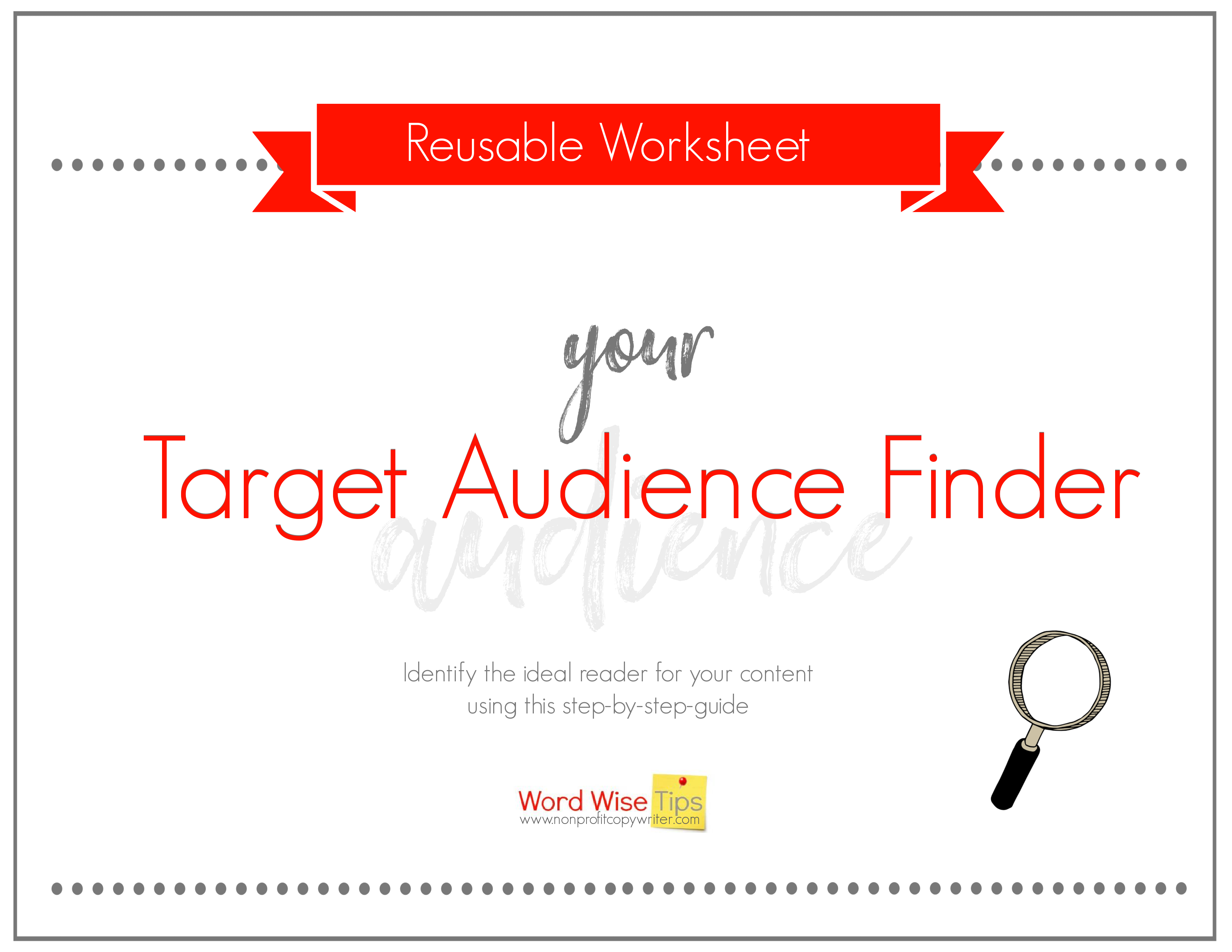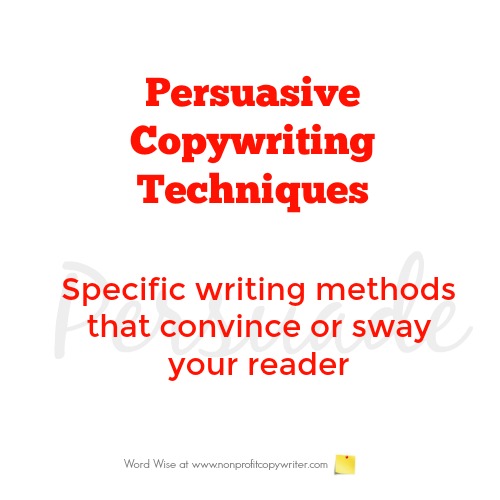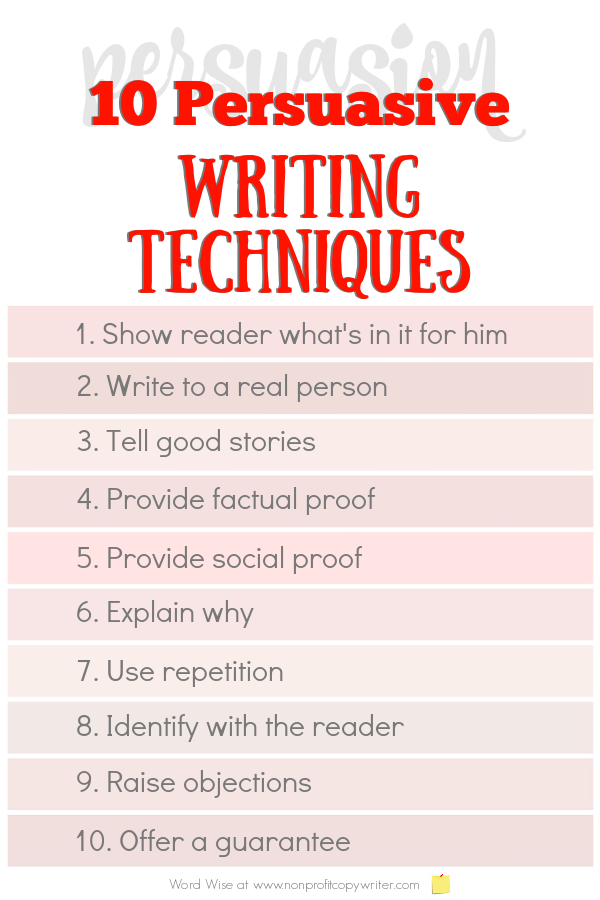
Top 10 Persuasive Copywriting Techniques
Award-winning writer Kathy Widenhouse has helped hundreds of nonprofits and writers produce successful content and has gained 600K+ views for her writing tutorials. She is the author of 9 books. See more of Kathy’s content here.
Updated 10.29.24
Persuasive copywriting techniques are specific methods you use to convince your reader, to act. Your words motivate readers to buy your product, give to your cause, click your link, download your freebie, sign up on your site.
By way of disclaimer, there is no magic bullet to writing persuasively.
Having said that, persuasive writers use certain elements over and over again – elements that have been proven to be convincing. These techniques are not complicated. In fact, as you read them, you’ll find yourself nodding and saying, “Yes, that would persuade me, too.” There’s a good chance you already use a few of these techniques as you write.
But you can be purposeful when you understand what those techniques are and how to use them.
And another encouraging tip: anyone can learn to use these persuasive tools. With a little bit of practice, these techniques can become part of your writing arsenal.
Top 10 Persuasive Copywriting Techniques
1. Show the reader what’s in it for him
It’s an undeniable fact: readers don’t care about you or your product or your biz or your blog. They care about what you can do for them.
Forgive me for sounding harsh. But if you doubt me, then do a quick self-check. Do you find yourself grieve deeply when you delete emails? Me, neither. You want a clean inbox. Do you purchase every product you see online? No, only those that you use and that you deem fits your needs.
Persuade your reader when you show you can do for him – offer a deal, answer a question, solve a problem, relieve suffering, give a freebie, change lives, or inspire others. Show your reader how you meet those needs for her and the benefits she gets.
2. Write to a real person
Understand your target reader. Write out a description of her. Know what she thinks, believes, feels, and knows.
Once you’ve identified your ideal target persona, keep that person front and center in your mind as you write. In fact, picture a person you know that fits your target profile. Write to that person as if she’s sitting across the table from you.
Your content will be more persuasive because you’ll write to that reader’s needs and wants. You’ll answer her specific questions and help solve the problems she has.

Use this Target Audience Finder to find your ideal reader.
3. Tell good stories
Storytelling offers the perfect opportunity to show rather than tell. And it goes further. A story creates an actual experience for the reader. She uses her senses, emotions, and memory to process the tale. Stories and anecdotes engage readers’ hearts and move them to act.
Plus, by using itty-bitty stories or anecdotes, you have the chance to present a problem and show what happened. Results are inspiring for bleeding hearts among your readers – and irrefutable for those who want “just the facts, ma’am.”
4. Provide factual proof
To that point, pair your stories with facts. All those yummy feelings raised in your stories? Support them with solid information and you’ll give your content a one-two punch.
Demonstrate benefits with logic. Pack your argument with statistics. Lay out the bare facts. Offer more than one source. Answers like these prevent “reader’s remorse” and appeal to the mind.
Human beings are a composite of right brain and left-brain activity. The best persuasive writing appeals to both. You will ooze credibility when you establish yourself as an authority by using expert information, data, and authoritative facts to corroborate your main point.
5. Provide social proof
People care what other people think. That’s why testimonials are so persuasive. Let others do the convincing for you. The more you can cite experts, researchers, partners, customers, donors, beneficiaries, volunteers, and celebrities, the more compelling your content will be.
6. Explain why
One of the most persuasive words to use in copywriting is “because.” People act when you give them a good reason to. Explain the benefits of your point, argument, product, service, or cause to your readers.
7. Use repetition
It’s a psychological principle: we hear information over and over again, our minds begin to think “it must be true.” One of the best ways to write persuasively is by repetition – saying an idea more than once.
The phenomenon is called “The Familiarity Principle,” developed by research psychologist Robert Zajonc. The more you are exposed to an idea – the more it is repeated – the more familiar it becomes. Repetition makes an idea easy to understand. Understanding is often taken as truth – and truth is persuasive.
8. Identify with the
reader
Speak directly the reader’s problem, struggle, or push back. Show you understand her hurt, pain, apathy, confusion, or other emotion. In other words, use plenty of "you" and "me" in your content.
The more rapport you build with the reader, the more persuasive you will be because she’ll think, “They get me. They’re like me.”
9. Raise objections
I admit it: it’s much easier to maintain the status quo rather than make a decision to buy a product or service, listen to a new argument, or consider a point of view different from my own. Readers are looking for any excuse to click off your page, toss your letter in the wastebasket, or move onto the next post.
You surprise a reader when you raise objections before they do. And you earn credibility when you address those objections with a satisfactory answer. Show readers both sides of the coin – that handful of weaknesses to your argument and how you refute them. A recent University of Illinois studies found that two-sided arguments are more persuasive to readers than one-sided counterparts.
10. Offer a guarantee
By offering an ironclad guarantee, you convince the reader to step across the line and plunk down their hard-earned money to buy your product or give to your cause. Of course, I’m referring to the familiar “money-back guarantee” offered to users who make a physical purchase. That kind of pledge provides assurance and a way out for your readers. A guarantee persuades them to act.
A word of warming. If you offer a guarantee and don’t deliver, then you lose your standing with your readers.
But beyond vowing that money can re-exchange hands, can you provide a guarantee in an article or blog post or tweet or any kind of content that’s not a monetary transaction? Yes. A guarantee is a promise. Any piece of good content lays out a promise in its opening sentences and then uses the subsequent paragraphs to make good on that promise.
For example, this article has a guarantee. I made a promise in the introduction: “Anyone can learn to use these persuasive tools. With a little bit of practice, these techniques can become part of your writing arsenal.”
Keep this checklist handy
Persuasive writing is not relegated to copywriters and admen. You want readers to embrace your point of view, don't you? If your answer is yes, then you're a member of the Persuasive Writers Club.
Keep this checklist handy as you read good content so you can quickly learn to recognize the best persuasive writing techniques. And use it as a guide when you write. Add these skills to your content one by one, and soon you'll be one of those writers who consistently convinces readers to act.
More Persuasive Writing Tips
Persuasave Writing: Facts Tell, But Stories Sell ...
Want to Persuade? Use the World’s Most Powerful Word ...
Use These 5 Persuasive Techniques in ANY Piece of Writing ...
Use A FOREST as a Persuasive Writing Checklist ...
Use This Simple Features vs Benefits Exercise to Avoid Deadly Boredom ...
Pillars that Persuade: Understand the 3 Persuasive Writing Basics ...
Persuasive techniques 1: one question you MUST answer ...
Persuasive techniques 2: write to real person ...
Persuasive techniques 3: tell a good story ...
Why You MUST Master Persuasive Storytelling ...
Persuasive techniques 4: give factual proof ...
10 Kinds of Facts That Persuade ...
Persuasive copywriting techniques 5: offer social proof ...
Persuasive techniques 6: explain why - use the Power of "Because" ...
Persuasive techniques 7: use repetition ...
Persuasive Writing Technique 9: Raise and Refute Your Reader's Objections
5 Basic Objections: How to Raise Them and Refute Them ...
Persuasive Writing Tip: How to Figure out Benefits Quickly ...
How to write persuasive stories ...
Persuasive writing basics: write to your prospect's needs ...
Use the "You Test" for More Persuasive Writing ...
Your 3-letter persuasive powerhouse ...
The Power of "New: It's not a gimmick - it's science ...
The 4 Ps: a writing formula and a persuasive writing tool ...
Star-Chain-Hook: A Simple (and Persuasive) Content Writing Formula ...
More persuasive writing tips on our Pinterest board ...
Return from Top 10 Persuasive Copywriting Techniques to
Nonprofit Copywriter home
As an Amazon Associate I earn from qualifying purchases.
Search This Site
Share This Page

Named to 2022 Writer's Digest list
BEST GENRE/NICHE WRITING WEBSITE


Stop Wasting Time!

Grab your exclusive FREE guide, "5 Simple Writing Tips You Can Put to Use in 10 Minutes or Less"










